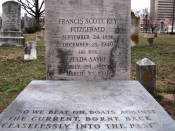In his novel The Great Gatsby, F. Scott Fitzgerald used the colors green, white, and yellow for symbolism-representing money, innocence, and corruption respectively. The use of symbolic color occurs throughout the novel, helping give a better understanding and description of characterization and setting.
In literature, green is often used to symbolize money, envy, and in Gatsby, Jay Gatsby's love for Daisy Buchanan. Fitzgerald most often used green to represent old money. This is a factor in Jay Gatsby's envy of Tom Buchanan's possessions, especially Daisy, and the people of old money who come to his parties. Green is used to represent this envy. Fitzgerald also used green to symbolize Gatsby's love for Daisy. He attained wealth for Daisy after being rejected because "rich girls don't marry poor boys." Gatsby described Daisy's voice as "full of money", and the green light at the end of her dock symbolized Gatsby's hope and a chance to relive the past with his true love.
Fitzgerald uses the color white to symbolize wealth, purity, innocence, cleanliness, and virginity, as well as laziness and a veil over corruption. Daisy is represented by the color white, helping to characterize her as the unattainable enchanted princess. When Daisy and Jordan are introduced to Nick, they are both wearing white, though their true corruption is revealed time and again throughout the novel. Fitzgerald used different shades of white to veil Daisy's corruption, such as the white powder she uses on her face. Daisy refers to her "white girlhood", a time when she was untouched by men and knew little of the real world. Corruption is also symbolized by white in Nick's dream: "four men dressed in suits are walking along the sidewalk with a stretcher on which lies a drunken woman in a white evening dress. Her hand,


